
In Lake Utonai-ko sanctuary, you can enjoy various aspects of beautiful nature all the year round. Here the rangers show you the highlights of each month.
January
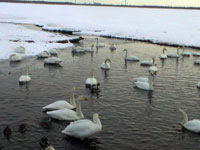 The coldest season. The lake's water is all frozen except a part of the lake where river water
flows in and out of the lake. Wintering Whooper Swans and Pintails gather in small open water areas, where they can be seen pushing-and-shoving each other.
The coldest season. The lake's water is all frozen except a part of the lake where river water
flows in and out of the lake. Wintering Whooper Swans and Pintails gather in small open water areas, where they can be seen pushing-and-shoving each other.
February
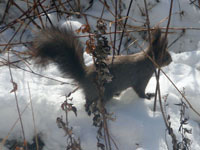 Footprints on the ground all covered with fresh snow tell us about some animals in the area. To look for the footprints of active nonhibernating KITAKITSUNE Ezo red fox Vulpes vulpes schrencki and EZORISU Hokkaido squirrel Sciurus vulgaris orientis is exciting.
Footprints on the ground all covered with fresh snow tell us about some animals in the area. To look for the footprints of active nonhibernating KITAKITSUNE Ezo red fox Vulpes vulpes schrencki and EZORISU Hokkaido squirrel Sciurus vulgaris orientis is exciting.
March
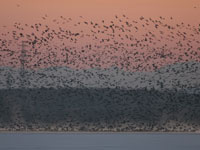 We know spring is coming by the arrival of migrating birds. It is the most attractive season for Lake Utonai-ko, which is one of the major stopover sites in Japan. To watch several tens of thousands of the White-fronted Goose and Bean Goose is spectacular. Everyday they commute between feeding stations on the field and their roost on the lake.
We know spring is coming by the arrival of migrating birds. It is the most attractive season for Lake Utonai-ko, which is one of the major stopover sites in Japan. To watch several tens of thousands of the White-fronted Goose and Bean Goose is spectacular. Everyday they commute between feeding stations on the field and their roost on the lake.
April
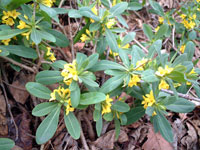 Spring ephemeral plants such as violets, and NANIWAZU Daphne pseudo-mezereum subsp jezoensis add colors to the forest floor that withered in winter. Summer birds like Stonechats, Reed Buntings and Woodcocks are arriving.
Spring ephemeral plants such as violets, and NANIWAZU Daphne pseudo-mezereum subsp jezoensis add colors to the forest floor that withered in winter. Summer birds like Stonechats, Reed Buntings and Woodcocks are arriving.
May
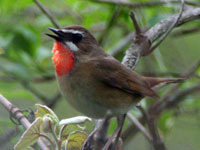 Mating and breeding season. Birds' songs by summer visitors, such as Siberian Rubythroat and Stonechat sound like a chorus.
Mating and breeding season. Birds' songs by summer visitors, such as Siberian Rubythroat and Stonechat sound like a chorus.
June
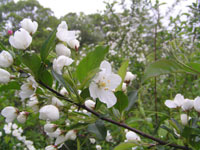 Dawn chorus by Siberian Rubythroat, Latham's Snipe, Narcissus Flycatcher and Brown-headed Thrush is really a singing contest, and they are very busy with their breeding. The blossoms of HASKAP Lonicera caerulea L. var. emphyllocalyx Nakai and EZONOKORINGO Malus baccata var mandshurica are blooming, so we can enjoy the most beautiful season in Hokkaido listening to bird songs and seeing flowers in bloom.
Dawn chorus by Siberian Rubythroat, Latham's Snipe, Narcissus Flycatcher and Brown-headed Thrush is really a singing contest, and they are very busy with their breeding. The blossoms of HASKAP Lonicera caerulea L. var. emphyllocalyx Nakai and EZONOKORINGO Malus baccata var mandshurica are blooming, so we can enjoy the most beautiful season in Hokkaido listening to bird songs and seeing flowers in bloom.
July
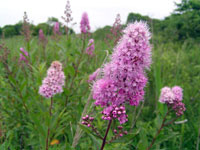 Only Grey Heron can be seen on the lake. In the forests and on the grasslands, birds are busy feeding their chicks. Bird songs get gradually fewer and fewer, but still lively voice of Gray's Grasshopper-warbler can be heard. Along the lake coast, pinkish HOZAKISHIMOTSUKE Spiraea salicifolia is in full bloom.
Only Grey Heron can be seen on the lake. In the forests and on the grasslands, birds are busy feeding their chicks. Bird songs get gradually fewer and fewer, but still lively voice of Gray's Grasshopper-warbler can be heard. Along the lake coast, pinkish HOZAKISHIMOTSUKE Spiraea salicifolia is in full bloom.
August
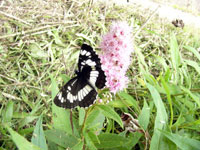 The wind blowing on the surface of the lake is the first sign of autumn. We suggest you look for Sand Martin and White-throated Needletail flying over the lake freely. Now the number of birds that can be seen is the least in a year. FUTASUJICHO butterfly Neptis rivularis and other insects are very active along the trails.
The wind blowing on the surface of the lake is the first sign of autumn. We suggest you look for Sand Martin and White-throated Needletail flying over the lake freely. Now the number of birds that can be seen is the least in a year. FUTASUJICHO butterfly Neptis rivularis and other insects are very active along the trails.
September
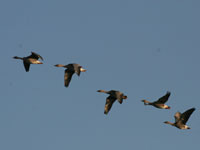 Long-awaited winter birds arrive. The first is waterfowl. Following them, Bean Goose comes in the middle of September and White-fronted Goose at the end of this month. Blue-purple flowers of EZORINDO Gentiana triflora var. japonica are on the grasslands, and trees and grasses turn to autumn colors.
Long-awaited winter birds arrive. The first is waterfowl. Following them, Bean Goose comes in the middle of September and White-fronted Goose at the end of this month. Blue-purple flowers of EZORINDO Gentiana triflora var. japonica are on the grasslands, and trees and grasses turn to autumn colors.
October
 It is the highest autumn migrating season. The number of birds migrating changes each day. Tundra Swan arrives at the beginning of the month, but soon it has to go south. The huge flocks of Tundra Swan seen in the morning sometimes all fly away in the afternoon. Siskin and other winter birds are recorded for the first time for this season, and fruits such as TSURUUMEMODOKI Oriental staff vine Celastrus orbiculatus become red and ripen.
It is the highest autumn migrating season. The number of birds migrating changes each day. Tundra Swan arrives at the beginning of the month, but soon it has to go south. The huge flocks of Tundra Swan seen in the morning sometimes all fly away in the afternoon. Siskin and other winter birds are recorded for the first time for this season, and fruits such as TSURUUMEMODOKI Oriental staff vine Celastrus orbiculatus become red and ripen.
November
 Even after the highest migrating season in October, some numbers of White-fronted Goose and Bean Goose still can be seen. So it is the best and the last chance to look for a small number of Snow Goose, Lesser White-fronted Goose and Canada Goose among them. Ducks are plenty now.
Even after the highest migrating season in October, some numbers of White-fronted Goose and Bean Goose still can be seen. So it is the best and the last chance to look for a small number of Snow Goose, Lesser White-fronted Goose and Canada Goose among them. Ducks are plenty now.
December
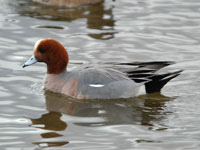 Male ducks' plumage changes to beautiful colors. Come to Lake Utonai-ko to watch them before the lake is frozen!
Male ducks' plumage changes to beautiful colors. Come to Lake Utonai-ko to watch them before the lake is frozen!